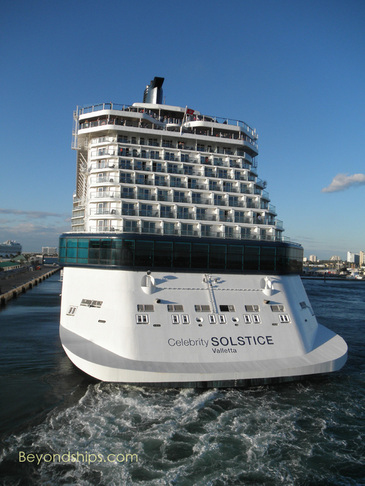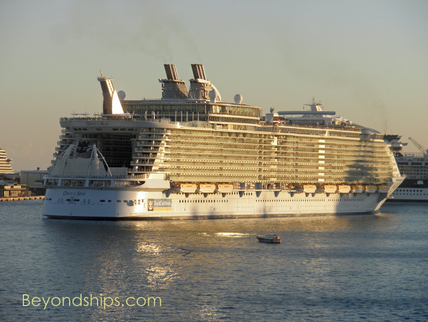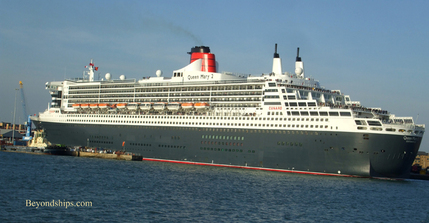What are pods and azipods?
|
The two pods on Celebrity Solstice stir up the water as she maneuvers away from the pier.
Oasis of The Seas using her three pods to maneuver within the close space of Port Everglades.
Queen Mary 2 has a combination of two rotating pods and two fixed pods. Here, she is using them to leave the Ocean Terminal in Southampton.
|
Pods are a relatively new system used for propelling ships through the water and for maneuvering them. The pod replaces both the traditional propeller and shaft as well as the rudder.
A huge steel casing suspended beneath the stern of the ship, a pod is sometimes described as looking like a giant outboard motor or a rudder with a torpedo-shape at the bottom At the front end of the pod is a propeller. The propeller is turned by an electric motor inside the pod. It gets its electricity via cables that come down through the pod from the ship’s power plant located inside the hull. Some pods are fixed while others can turn 360 degrees. This latter rotating form of pod is called an “azimuthing pod." The term "azipod" is a contraction of the terms "azimuthing" and "pod." “Azipod” is a registered trademark of ABB Oy. (See interview about the ABB system). Other manufacturers market pod systems that employ a similar concept under other brands. One benefit of a rotating pod system is that it increases the ship’s maneuverability. As above, the pods can turn can turn 360 degrees. Thus, each pod can be turned in any direction. “Whatever direction the propeller is facing that is how it is going to pull. So you can put it at 90 degrees to move the ship sideways and use them in conjunction with the bow thrusters for turning in circles or sideways,” says Captain James MacDonald of Royal Caribbean. The propeller is on the front of the pod and thus pulls the ship through the water rather than pushes it as with a traditional propeller and shaft system. In the traditional system, the propeller is turning in water that has been disturbed by the passage of the ship’s propeller shaft, framings and brackets. In an pod system with the propeller on the front of the pod, the propeller is turning in undisturbed water. “The [pod] is about 5 or 6 percent more efficient because of the better water flow,” explains Holland America’s Captain John Scott. In addition, Chief Engineer Brian Watling of Cunard’s Queen Mary 2 points out that with a traditional system, “you tend to get a little more noise through the ship on maneuvering because of the cavitations of the propellers. We don’t get that with the pods we have because they are tractor pods - - they are pulling the ship through the water so you get nice, clean water going into the blades which cuts down any noise cavitations.” Yet another benefit is that the pod system frees up more space within the ship’s hull. With a traditional system, the propeller shafts and the motors that drive them have to be located with the hull. In addition, a modern cruise ship that does not have pods has to be equipped with stern thrusters in order to maneuver when docking and undocking. With a pod system, the equivalent of the propeller shaft and the drive motor are located within the pod, not in the hull. Furthermore, there is no need for stern thrusters. Most cruise ships have two pods. However, Oasis of the Seas and Allure of the Seas have three pods. Several ships have a combination of azimuthing pods and pods that do not turn (sometimes called “fixipods”) that are used to provide forward and backwards propulsion. Not all cruise ships use pods. Ships like Norwegian Epic, Carnival Dream and Ruby Princess use the traditional system. In part this is due to the fact that there were some problems with the pod system when it first debuted. In addition, there have been technological improvements with the traditional system making it significantly more maneuverable than in the past. Sometimes, it is because the new ship is based upon an earlier design that used the traditional system and why make radical and costly changes to a successful design. |
|
|
|
Cruise ship FAQs - - What are azipods?


